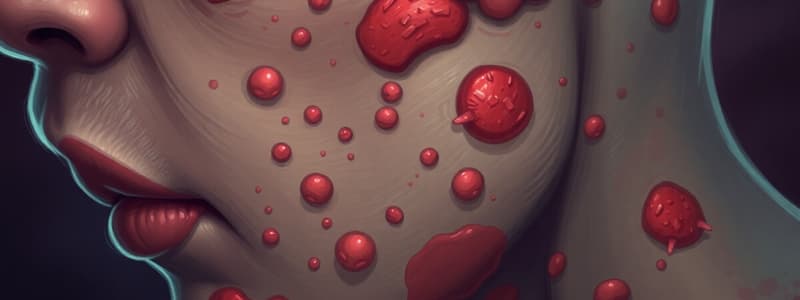Podcast
Questions and Answers
What is a defining characteristic of Toxic Epidermal Necrolysis (TEN)?
What is a defining characteristic of Toxic Epidermal Necrolysis (TEN)?
- Presence of widespread urticaria.
- Localized bullae without systemic symptoms.
- Severe erythema followed by detached epidermis. (correct)
- Development of conjunctivitis as the first symptom.
In patients with Chronic Erythema Multiforme, what typically initiates the condition?
In patients with Chronic Erythema Multiforme, what typically initiates the condition?
- Bacterial infection in the skin.
- Allergic reaction to medications.
- Cell mediated immune reaction to recurrent HSV infection. (correct)
- Viral infection with HIV.
When do mucous membrane lesions typically appear in relation to skin lesions in skin conditions described?
When do mucous membrane lesions typically appear in relation to skin lesions in skin conditions described?
- 1-2 weeks before skin lesions. (correct)
- 1-2 weeks after skin lesions.
- Simultaneously with skin lesions.
- Only after the skin lesions have healed.
Which of the following complications can arise from severe skin lesions?
Which of the following complications can arise from severe skin lesions?
What sign is indicative of skin peeling in cases of Toxic Epidermal Necrolysis (TEN)?
What sign is indicative of skin peeling in cases of Toxic Epidermal Necrolysis (TEN)?
What is primarily characterized by oral, skin, eye, and genital involvement with painful vesiculobullous lesions?
What is primarily characterized by oral, skin, eye, and genital involvement with painful vesiculobullous lesions?
Which of the following factors is NOT associated with the initiation of erythema multiforme?
Which of the following factors is NOT associated with the initiation of erythema multiforme?
In which condition would you expect to find the presence of Nikolsky's sign?
In which condition would you expect to find the presence of Nikolsky's sign?
What type of skin lesions are referred to as iris or target lesions in erythema multiforme?
What type of skin lesions are referred to as iris or target lesions in erythema multiforme?
What is the typical healing time for lesions associated with major forms of erythema multiforme, like Steven Johnson's syndrome?
What is the typical healing time for lesions associated with major forms of erythema multiforme, like Steven Johnson's syndrome?
Flashcards are hidden until you start studying
Study Notes
Erythema Multiforme (EM) Definition and Etiology
- Acute, self-limiting inflammatory disease affecting skin and oral mucosa.
- Characterized by multiple cutaneous lesions (vesiculobullous).
- Immunologically mediated, potentially triggered by:
- Immune complex deposition (IgM and C3) in superficial microvasculature.
- Herpes simplex virus.
- Drug reactions (antibiotics, barbiturates, carbamazepine, sulfonamides).
- Cell-mediated immunity (especially in herpes-associated EM).
EM Types
- Major form: Includes Stevens-Johnson syndrome (SJS) and toxic epidermal necrolysis (TEN).
- Minor form: Less severe, without systemic manifestations.
- Chronic form: Occurs in immunosuppressed patients.
- Herpes-associated EM: Triggered by recurrent HSV infection.
Stevens-Johnson Syndrome (SJS)
- Mucocutaneous-ocular syndrome involving oral, skin, eye, and genital areas.
- Sub-epithelial vesiculobullous lesions.
- Affects infants, children, and young adults; both sexes equally.
- Sudden onset with fever, headache, malaise, and rapid development of severe lesions (24-48 hours).
- Fever persists for 4-5 days, with patient appearing frustrated and dehydrated for 1-2 weeks.
- Oral lesions: Vesicles rupture, forming large, shallow, irregular, painful ulcers surrounded by erythema; hemorrhagic ulcers are common. Rarely found on gingiva.
- Positive Nikolsky’s sign often present on red oral mucosa.
- Lip lesions present as bloody crusted lesions.
- Tongue shows enlargement, marginal indentations, and erosion.
- Skin lesions: Maculopapular lesions, iris/target lesions (concentric erythematous rings), vesiculobullous lesions (leading to extensive skin sloughing).
- Eye lesions: Diffuse conjunctivitis, corneal ulceration (potential for scarring and blindness).
- Urogenital lesions: Nonspecific urethritis and balanitis (males); vaginal ulcers (females).
Toxic Epidermal Necrolysis (TEN)
- Severe form of EM, often drug-induced.
- Affects skin and mucous membranes of the mouth, throat, nasal passages, trachea, conjunctiva, genitals, and anus.
- Mucous membrane lesions may precede skin lesions by 1-2 weeks.
- Characterized by:
- Severe erythema progressing to vesiculobullous lesions and epidermal detachment (resembling a burn).
- Positive Nikolsky’s sign with extensive skin peeling.
- Systemic illness with high fever.
- Risk of death due to secondary infection, fluid and electrolyte imbalance.
- Healing usually scar-free unless secondary infection occurs.
Minor Erythema Multiforme
- Skin and/or oral mucous membrane involvement without systemic manifestations.
- Clinical features similar to major form, but less severe.
Chronic Erythema Multiforme
- Rare type, associated with immunocompromised patients.
Herpes-Associated Erythema Multiforme
- Cell-mediated immune reaction to recurrent HSV infection.
- Onset 10-14 days after recurrent herpes infection (labialis or genital).
- Prophylactic acyclovir may prevent recurrence. Acyclovir isn't effective once lesions appear.
Diagnosis of EM
- Done by exclusion of other diseases.
- History: Sudden onset (1-2 days for minor; fever then rapid lesion development for major); recurrence; potential link to HSV infection 10-14 days prior.
- Clinical examination: Oral lesion characteristics are typical; skin examination is crucial.
- Special investigations: No specific diagnostic tests; lab tests helpful for ruling out other conditions.
Course and Prognosis of EM
- Minor form: Lesions last 2-3 weeks.
- Major form and chronic type: Lesions last up to 4 weeks.
- Self-limiting; resolves without scarring unless secondary infection occurs.
- Generally good prognosis, though major form carries mortality risk.
Treatment of EM
- Mild cases: Supportive care (soft/liquid diet); topical steroids for lesions; topical anesthetics for pain; tetracycline for infection.
- Moderately severe cases: Systemic steroids (prednisone 30-50mg/day or more), systemic antibiotics (if secondary infection), ophthalmological consultation (if conjunctivitis involved).
- Severe cases: Hospital admission for feeding assistance, fluid balance correction, potential skin grafting (TEN), and management of complications.
- Prophylactic antiviral drugs (e.g., acyclovir 400mg/day) for recurrent herpes-associated EM to prevent recurrence.
Studying That Suits You
Use AI to generate personalized quizzes and flashcards to suit your learning preferences.




